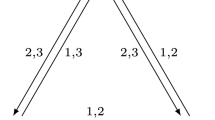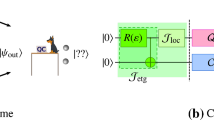Game theory suggests quantum information processing technologies could provide useful new economic mechanisms. For example, using shared entangled quantum states can alter incentives so as to reduce the free-rider problem inherent in economic contexts such as public goods provisioning. However, game theory assumes players understand fully the consequences of manipulating quantum states and are rational. Its predictions do not always describe human behavior accurately. To evaluate the potential practicality of quantum economic mechanisms, we experimentally tested how people play the quantum version of the prisoner’s dilemma game in a laboratory setting using a simulated version of the underlying quantum physics. Even without formal training in quantum mechanics, people nearly achieve the payoffs theory predicts, but do not use mixed-strategy Nash equilibria predicted by game theory. Moreover, this correspondence with game theory for the quantum game is closer than that of the classical game.
Similar content being viewed by others
References
R. Aumann and S. Hart (eds.), Handbook of Game Theory with Economics Applications, Vol. 1 (Elsevier, 1992).
Axelrod R., Hamilton W. (1981). Science 211: 1390
R. Axelrod, in Genetic Algorithms and Simulated Annealing, edited by L. Davis Chapter 3, (Morgan Kaufmann, Los Altos, CA, 1987). pp. 32–41.
Bagnoli M., Lipman B.L. (1989). Rev. Econ. Stud. 56, 583
Benjamin S.C., Hayden P.M. (2001). Phys. Rev. A 64, 030301
C. Camerer, in The Handbook of Experimental Economics, edited by J. Kagel and A. E. Roth chapter 8, (Princeton University Press, 1995) pp. 587–703.
Camerer C., Ho T., Chong J.-K. (2004). Quart. J. E. 119(3): 861
K.-Y. Chen, T. Hogg, and R. Beausoleil, Quant. Inform. Process., 1, 449 (2002). arxiv.org preprint quant-ph/0301013.
K.-Y. Chen and R. Wu, in Proceeding of the 5th International Conference on Enterprise Information Systems (ICEIS), April 2003.
Du J., Li H., Xu X., Zhou X., Han R. (2002). Phys. Lett. A 302, 229 arxiv.org preprint quant-ph/0110122.
Du J., Li H., Xu X., Shi M., Wu J., Zhou X., Han R. (2002). Phys. Rev. Lett. 88, 137902 arxiv.org preprint quant-ph/0104087.
Eisert J., Wilkens M., Lewenstein M. (1999). Phys. Rev. Lett. 83: 3077 arxiv.org preprint quant-ph/9806088.
Eisert J., Wilkens M.J. (2000). Modern Optics 47: 2543 arxiv.org preprint quant-ph/0004076.
Feynman R.P. (1985). QED: The Strange Theory of Light and Matter. Princeton University Press, NJ
Glance N.S., Huberman B.A. (1994). Scientific American 270(3): 76
Groves T., Ledyard J.O. (1977). Econometrica 45, 783
Hardin G. (1968). Science 162: 1243
Huberman B.A., Hogg T. (2003). Quant. Inform. Process. 2: 421 arxiv.org preprint quant-ph/0306112.
J. Ledyard, in Handbook of Experimental Economics, edited by J. Kagel and A. Roth, chapter 2, (Princeton University Press, 1995) pp. 111–181.
Meyer D.A. (1999). Phys. Rev. Lett. 82: 1052 arxiv.org preprint quant-ph/9804010.
D. A. Meyer, in Quantum Communication, Measurement and Computing, Vol. 734, AIP Conference Proceedings, 2004, pp. 36–39.
P. L. Mura, arxiv.org preprint quant-ph/0309033, (2003).
Noreen E. (1989). Computer-Intensive Methods for Testing Hypotheses. John Wiley, NY
T. R. Palfrey and H. Rosenthal, in Laboratory Research in Political Economy, edited by T. R. Palfrey (University of Michigan Press, 1991), pp. 239–267.
Thaler R.H. (1988). J. Econ. Perspect. 2(4): 195
van Enk S.J., Pike R. (2002). Phys. Rev. A 66: 024306
Zhang L., Hogg T. (2003). Intl. J. Quant. Inform. 1(3): 321
Author information
Authors and Affiliations
Corresponding author
Rights and permissions
About this article
Cite this article
Chen, KY., Hogg, T. How Well Do People Play a Quantum Prisoner’s Dilemma?. Quantum Inf Process 5, 43–67 (2006). https://doi.org/10.1007/s11128-006-0012-7
Received:
Accepted:
Published:
Issue Date:
DOI: https://doi.org/10.1007/s11128-006-0012-7




